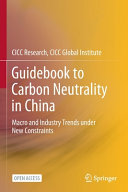

Most ebook files are in PDF format, so you can easily read them using various software such as Foxit Reader or directly on the Google Chrome browser.
Some ebook files are released by publishers in other formats such as .awz, .mobi, .epub, .fb2, etc. You may need to install specific software to read these formats on mobile/PC, such as Calibre.
Please read the tutorial at this link: https://ebookbell.com/faq
We offer FREE conversion to the popular formats you request; however, this may take some time. Therefore, right after payment, please email us, and we will try to provide the service as quickly as possible.
For some exceptional file formats or broken links (if any), please refrain from opening any disputes. Instead, email us first, and we will try to assist within a maximum of 6 hours.
EbookBell Team

5.0
70 reviewsThis Open Access publication focuses on China’s goal of achieving peak carbon emissions in 2030 and carbon neutrality by 2060. The book is the first to systematically build a framework combining a top-down and bottom-up analysis of this acute topic.
What does carbon neutrality mean for economics in China? Might it imply stagflation or is it an opportunity to maximize the potential of green manufacturing?
The book offers a comprehensive analysis of how the pursuit of carbon neutrality may influence the development of China's economy, and the country's biggest industries, while foreseeing the likely changes in people's lifestyles.
In total, the book constructs a comprehensive path for China's carbon neutrality drive from the perspective of the green premium. This effort lays the foundation for a discussion of the country's emissions reduction plan.
The book goes further, calculating the investment required for different sectors to achieve carbon neutrality, and illustrating the roles of carbon pricing and green finance in this undertaking.
The book’s information comes from a network of primary sources, including experts in the field and noted academics, to depict potential low-carbon roadmaps and green transitions in major industries.
Emphasized is green development in sectors that will be critical to civilization, including in technology, energy, manufacturing, transportation, and urban planning, which are backed by in-depth discussions and analyses.
Accessible and academically rigorous, the work is anchored in the economics of carbon neutrality, extends to potential policy implications and identifies investment opportunities.
This valuable reference will attract readers interested in public policy, economics, finance, and investors who seek to better understand China's prospects in the low-carbon economy of the near future.